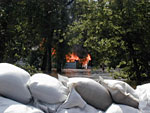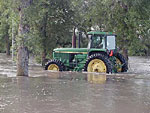By MPR Newsroom
Associated Press
June 25, 2002
| |
|
|
|
||
ADA, Minn. (AP) - The Wild Rice River crested here, beating a record set two weeks ago, but officials were confident Tuesday their dikes would protect the northwestern Minnesota town.
"We've learned not to be relieved until the water leaves town, and we hope it doesn't come back this time," said a cautiously optimistic Kevin Ruud, Norman County's emergency director.
Ruud said the river peaked at 17.58 feet late Monday night and had dropped 4 inches by 9 a.m. Flooding problems begin in Ada when the river reaches about 14 feet. The record crest set two weeks ago was 16.8 feet.
"We're going to have a slow decrease for 24 to 36 hours, then it will start to drop a little faster," he said.
Residents of the town of 1,650 and the U.S. Army Corps of Engineers added a 4-foot topping of clay to Ada's permanent dike earlier in the week when the second round of torrential rains in two weeks started the river rising. Workers dug the clay out of the county fairgrounds, leaving deep craters where the annual fair is supposed to begin Wednesday.
| |
|
|
|
||
No evacuations were ordered in Ada or upstream in Mahnomen, which was also fighting back floodwaters.
Ruud was relieved that the heavy rains that much of Minnesota experienced Monday stayed away from Ada and there was no rain in the forecast.
"We dodged a bullet last night," he said.
Ruud said the crisis should pass once the high water dumps into the Red River, where its 19,000 cubic feet per second will be "just a drop in the bucket," less than 10 percent of the Red's maximum flow.
Once the floodwaters recede, officials will be able to assess the extent of damage, Ruud said.
The Wild Rice River began its latest rise after 10 to 12 inches of rain fell Saturday night and early Sunday, washing out roads and submerging cropland for the second time this month. Another 1 inch to 1½ inches of rain fell in the area early Monday.
The water spread across the flat landscape to as much as six miles wide in some parts of the area, Ruud said.
| |
|
|
|
||
But farmers simply shrugged. Crops on about 240,000 acres, half the acreage in Norman County, were wiped out by the flood two weeks ago, a loss of about $36 million.
Extension educator Ken Pazdernik said he didn't expect any new major losses. But, he said, "Now, with the extra water, it keeps land saturated and creates more problems for crops to survive."
In Mahnomen, Jack Hausner thought he had saved his pictures of his late wife and his collection of three dozen guns by moving them upstairs Sunday as floodwaters inundated his home. But on Monday, his house caught fire and the flood prevented fire trucks from getting near it.
His was one of 19 homes damaged by floodwater in the town of 1,200.
Mahnomen Mayor Darvin Schoenborn said there was no official flood stage in the town, nor a measured crest. But he said, "I've lived here for 48 years and I've never in my wildest dreams imagined the river would ever rise like that."
Ray Bisek, extension educator for Mahnomen County, estimated crop losses at $7 million to $9 million after the two rounds of flooding. About 20 percent to 25 percent of the county's crops have been wiped out, he said.
The trouble wasn't confined to the Wild Rice River.
Near International Falls along the Canadian border, residents along the Rainy, Bigfork and Littlefork rivers coped with fast-rising water after the weekend storms.
And in Roseau, a town 10 miles south of the border that was covered by the rain-swollen Roseau River two weeks ago, residents don't have enough electricians, plumbers and contractors to make homes livable again. Some residents are unsure whether to repair their homes because they are in a zone the city may take over to widen its levee.
Just more than a week ago, President Bush declared 13 northwestern Minnesota counties a federal disaster area after flooding from previous rainstorms.
The renewed flooding meant more trouble for farmers, and Gov. Jesse Ventura asked U.S. Agriculture Secretary Ann Veneman on Monday for an agricultural disaster declaration for the 13 counties.



